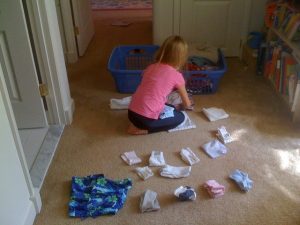Everyday Adventures in Early Math Counts
Just mentioning math can strike fear into the heart of even the most educated parent! While many of us are quite skilled with math, it has still become a common “fear” for many folks. Yet, still, those of us with older children have been quite perplexed as the methods for mastering math in school has changed over the years. Our methods are not the same as they used to be! We also seem to forget that young children are not learning algebra, geometry and calculus. Perhaps it was these subjects that instilled fear in us in the past?
Instead, young children are ready to learn one-to-one correspondence, sorting, sequencing, number, counting, and shapes. Much simpler, right? However, these skills can still seem challenging for parents to support in their child’s development. Are workbooks, worksheets, computer programs or apps the best to practice these skills? How can we know that our children are “ready for school” when it comes to math?
Math skills can be practiced each and every day at home or at school. First, include your child in everyday tasks, even those you would not think they can do well. Tasks such as laundry, cleaning, cooking, maintenance, shopping and caring for pets can be turned into math practice! Here are some suggestions for including your child in every day math practice.
- Laundry: Sorting laundry by type, family member and size. Match and count the pairs of socks. Fold clothing in half and half again. Measure detergent with child sized cups.
- Cleaning: Using child sized spray bottles, clean the table by counting squirts before wiping it down. Sweep the floor in a circle or square shape. Use sponges cut into different shapes to clean different items. Categorize dishes and wash by category, such as round plates, square plates, round bowls and mugs, etc. Create a pattern by washing first a plate, then a cup then a bowl and repeating until dishes are clean.
- Cooking: Whenever possible, include children in the cooking and food preparation. Use plastic measuring cups to measure ingredients and a wooden spoon to stir. Use a butter knife to cut vegetables into small or large chunks. Estimate how long it will take to cook or bake and then discuss the reality versus guess.

- Grocery Shopping: Create a list children can check off to practice one-to-one correspondence. Sort the cart by type of items, such as those in boxes or not, cold or room temperature, etc. Count items in the cart. Pack unbreakable groceries in paper bags trying to fit them in safely without crushing them. Weigh bulk foods, adding and subtracting amounts to get to one pound.
- Routines: For the morning routine, use a picture chart to put the steps to getting ready in order for children to follow. For bedtime routine, use a timer or a picture clock to show the amount of time rather than the actual time. Read books including numbers, counting, sorting and classifying. Use a picture schedule showing a picture of each main activity during a stay at home day so children can follow the schedule and manipulate when things change.
Remembering that math skills for little ones is more than just algebra will make a big difference in how you perceive math as a parent. Have fun with mathematics and go beyond just helping children memorize numbers in order. Look to everyday tasks you may find tedious for opportunities to include learning moments. It is easier than you may think and way more fun!

Block Play can also be used with talking to children about patterns. Children can work together using the different shapes to make fences (square,rectangle,square, rectangle…
I love how blocks are such a great activity for children to play together.
I appreciate including math skills in our everyday routines. Sorting socks then putting one sock on one foot and repeating…two feet, two shoes. Through out the day math can be involved in stacking canned foods in the pantry and counting oranges in the fruit bowl. Of course, setting the table with one plate, fork, spoon, knife, napkin per person again relates to one-to-one correspondence but also how many sets are needed to meet the needs of the family. Even in clean up time, math comes into play. How many books will fit on the shelf? These daily activities are loaded with math possibilities. Use them wisely and fill them with communication and fun.
Another way that math can be done at home is you can have them count out there snack.
This is a great idea to put in the news letter for parents to create math at home learning experiences. It is another way to incorporate what you are doing in the classroom and have parents practice with their child at home. Cute idea.
Gardening is a good way to include counting and patterning in everyday life.
table setting for a family good for math when it come to counting and caring fora pet it is a good source of adding and subtraction. And a very good pattern.
I’m glad I saw this one because I have been doing it in everyday teaching and not realizing it’s math!
When you mentioned the grocery store and kids having a list, it made me think that I can create a grocery store for dramatic play and have a few different grocery lists. Going to have to start creating this for future use.